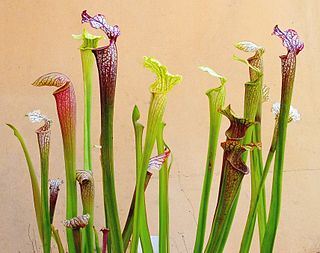
Crinum is a genus of about 180 species of perennial plants that have large showy flowers on leafless stems, and develop from bulbs. They are found in seasonally moist areas, including marshes, swamps, depressions and along the sides of streams and lakes in tropical and subtropical areas worldwide.

Sarracenia is a genus comprising 8 to 11 species of North American pitcher plants, commonly called trumpet pitchers. The genus belongs to the family Sarraceniaceae, which also contain the closely allied genera Darlingtonia and Heliamphora.

Amorpha is a genus of plants in the pea family, Fabaceae. All the species are native to North America, from southern Canada, most of the United States (US), and northern Mexico. They are commonly known as false indigo. The name Amorpha means "deformed" or "without form" in Greek and was given because flowers of this genus only have one petal, unlike the usual "pea-shaped" flowers of the Faboideae subfamily. Amorpha is missing the wing and keel petals.

Indigofera is a large genus of over 750 species of flowering plants belonging to the pea family Fabaceae. They are widely distributed throughout the tropical and subtropical regions of the world.

Crinum latifolium is a herbaceous perennial flowering plant in the amaryllis family (Amaryllidaceae). It arises from an underground bulb. The flowering stems are stout, reaching about 2 m in height. The leaves are long, linear and ligulate. The flowers are white and arranged in an umbel. It grows naturally in Asia, from India and Sri Lanka through much of mainland Southeast Asia to south China. It is also reportedly naturalized in the West Indies and in the Chagos Archipelago.

Crinum pedunculatum also known as the swamp lily, river lily or mangrove lily, is a bulbous perennial found in stream and tidal areas of the Northern Territory, Queensland and New South Wales, Australia as well as New Guinea and some Pacific Islands. It is unclear whether it is native or introduced to Norfolk Island.

The hybrid elm cultivar Ulmus × hollandica 'Wredei', also known as Ulmus × hollandica 'Dampieri Aurea' and sometimes marketed as Golden Elm, originated as a sport of the cultivar 'Dampieri' at the Alt-Geltow Arboretum, near Potsdam, Germany, in 1875.
The Field Elm cultivar Ulmus minor 'Viminalis Marginata', a variegated form of Ulmus minor 'Viminalis', was first listed as Ulmus campestris var. viminalis marginataHort. by Kirchner in 1864. Both Van Houtte and Späth marketed an U. campestris viminalis marginata in the late 19th century.

Crinum bulbispermum is a herbaceous plant native to South Africa, Lesotho and Eswatini. It is naturalized in the Lesser Antilles, Honduras, Cuba, Florida, Texas, Louisiana, Alabama, South Carolina and North Carolina. Crinum bulbispermum is the floral emblem of the Free State province of South Africa.

Crinum asiaticum, commonly known as poison bulb, giant crinum lily, grand crinum lily, or spider lily, is a plant species widely planted in many warmer regions as an ornamental. It is a bulb-forming perennial producing an umbel of large, showy flowers that are prized by gardeners. However, all parts of the plant are poisonous if ingested. Some reports indicate exposure to the sap may cause skin irritation.

Calochortus elegans is a species of flowering plant in the lily family known by the common name elegant Mariposa lily, cat's ear, elegant cat's ears or star tulip. It is native to the western United States from northern California to Montana.

The scientific name × Amarcrinum is applied to those hybrid plants obtained from artificial crosses between the genera Amaryllis and Crinum, although as of March 2014, the World Checklist of Selected Plant Families regards the name as "unplaced". They are grown as ornamental plants in gardens.

Opuntia fragilis, known by the common names brittle pricklypear and little prickly pear, is a prickly pear cactus native to much of western North America as well as some midwestern states such as Illinois, Iowa, Wisconsin and Michigan. It also occurs in several Canadian provinces. It is known from farther north than any other cactus, occurring at as far as 56°N latitude in British Columbia. There is an isolated and possibly genetically unique population in Eastern Ontario known as the "Kaladar population".

Nerine bowdenii is a species of flowering plant in the family Amaryllidaceae. It is an herbaceous bulbous perennial, growing to 45 cm (18 in) tall by 8 cm (3 in), with strap-shaped leaves and large umbels of lily-like pink flowers in late summer and autumn. The common names of the species are Cornish lily, Cape flower, Guernsey lily, and Bowden lily. However, it is neither a true lily nor from Cornwall or Guernsey, but originates from South Africa. Confusingly the name “Guernsey lily” is also applied to a related species, Nerine sarniensis.

Urceolina is a genus of South American plants in the amaryllis family native to Bolivia, Brazil, Colombia, Costa Rica, Ecuador, Guatemala, Panama, and Peru. It has also been introduced to many South and Central American states, as well as India and Sri Lanka. The formerly accepted genera Eucharis and Caliphruria are now regarded as synonyms of this genus. Many species of this genus share the common name Amazon lily.

× Gasteraloe (× Gastrolea) is a genus of hybrid plants, from mixtures of species from the Aloe or Aristaloe and Gasteria genera. Since most species in the genus originated as hybrids, the genus is sometimes called a "nothogenus".

Crinum lorifolium is a species of flowering plants in the family Amaryllidaceae. It is found in India and Myanmar.
Louis Percival Bosanquet was a citrus farmer and horticulturist who lived in Fruitland Park, Florida. He is best known for his crinum lily hybrid and for introducing the camphor laurel tree to Florida.
















